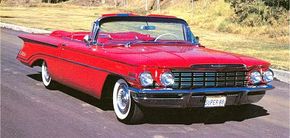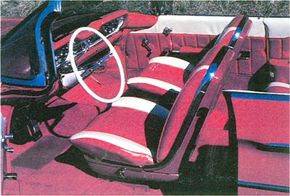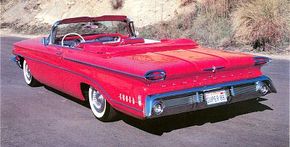"Every view is refreshingly new," boasted the sales brochure for the restyled 1960 Oldsmobile. Sounds like typical advertising hype; but this time, at least, it was basically true. Essentially reskinned below the belt, the first big Oldsmobile of the 1960s closely followed the enlarged "Linear Look" of the prior year, but had a more subdued and dignified demeanor than the dreamboats it replaced.
Advertisement
Each pair of headlights sat closer together, separated only by a narrow insignia. That left space for a wider grille made up of 24 bright blocks arranged in three rows. The hood's leading edge contained a wide scoop-styled nameplate, mating with the pronounced bodyside crease that ran around front fenders to stretch all the way back to the protruding horizontal taillamps.
A lower bodyside trim strip ran alongside another creaseline, tapering down behind the rear wheel opening, which itself displayed a graceful tapering-off. Twin creases decorated the decklid, and round backup lights were built into the massive, arched bumper.
Promotional drawings exaggerated the broad expanse of the back end, but the artist needn't have bothered. The decklid was plenty wide enough in real life.
So, did all these styling touches add up to the "fresh, balanced, enchanting symmetry" promised in the brochure? Well, maybe that's reaching a tad too far. Gaudiness wasn't exactly gone. The compound-curve windshield remained. So did the Holiday hardtop sedan with its flat-top roof extending beyond a radically wrapped back window. Let's be satisfied by admitting that the latest Oldsmobile was a substantial improvement over 1959, and vastly cleaner than the chrome-riddled 1958.
Oldsmobile customers liked their comforts, and the 1960 Oldsmobiles had plenty to offer. "Quadri-balanced Ride" was claimed to emanate from the wide-stance chassis. Vibra-Tuned body mounting at points of minimum vibration, insisted the copywriters, would insulate passengers from road noise and harshness.
Convenience options ran the gamut from Guide-Matic that dimmed the headlights automatically, to a four- or six-way power seat and power decklid release. If flipping the vent glass open and shut sounded just too, too taxing, powered ventipanes were available. Three-seat Fiesta station wagons came with a power window lift that dropped the glass into the tailgate.
Go to the next page to read more about the body and interior styling of the 1960 Oldsmobile.
For more information on cars, see:
- Classic Cars
- Muscle Cars
- Sports Cars
- Consumer Guide New Car Search
- Consumer Guide Used Car Search
Advertisement


